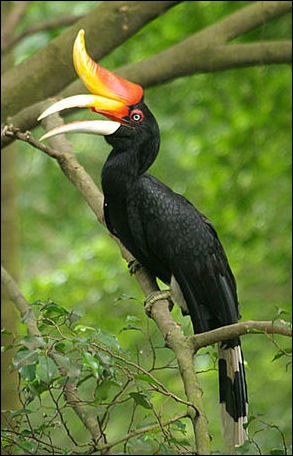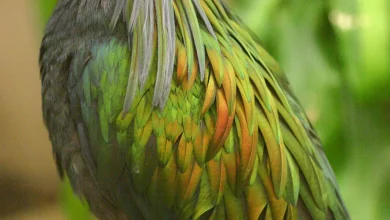HORNBILLS, THEIR NEST-BUILDING BEHAVIOR AND SPECIES IN ASIA
HORNBILLS THEIR NEST BUILDING BEHAVIOR AND SPECIES IN ASIA

HORNBILLS
Hornbills are an species of bird that is named for huge horn-like bills that can be found on all species. . It is home to 54 different species of hornbills, 23 species that live in the savannahs and forests that are found in Africa as well as 31 species from Asia that are found mostly within tropical rainforests. There are only four species to the east from the Wallace Line. [Source: Michael Long, National Geographic, July 1999]
Hornbills first appeared in fossil record around fifteen million years back. They appear in a variety of legends about tribes in Southeast Asia and Indonesia. Borneo hill tribes consider rhinoceros as hornbills that deliver souls into the next world. In the western part of Borneo there is a ceremony to honor the hornbills occurs at least every 5 to 7 years. On Sumba they are the symbol of loyalty.
Hornbills are only found on only the Old World
Toucans are thought of as an equivalent of their New World equivalent. The largest hornbills are similar to turkeys. The smallest one is the dimension of doves. The majority of them have horn-like casques that are attached to their bills. Certain birds can have a lifespan of up to 45 years.
Hornbills in many species are threatened or in danger because of destruction of habitat, deforestation and hunts for their feathers, bills and even meat. Many have fallen victim to poisons left on the table to other animals. Others are killed by poachers who sell the chicks of are species for up to $1000 per piece.
Hornbill Characteristics
Hornbills have long curving bills which are predominantly yellow and can grow to lengths of up to 13 inches. Bills are an essential part of the skull of the hornbill and is utilized by the bird to eat or fight, as well as to create nests, and stop snakes away from the weak areas of their bodies. The development of the bill is often an indicator of sexuality and the age of the bird.
The casque is thought to function principally as a ridge for reinforcement at the bill’s top. However, it could be a part of sexual selection as well as amplifying the bird’s call. In a variety of species it has been transformed into an resonator that is hollow. The hornbill’s casque is helmeted. is made of solid ivory . It makes an 11-percent bodyweight of the skull. The form of the casque is usually the most simple way to determine the species.
The strong muscles of the neck inhornbillswhich
support the head. They also have two vertebrae that are fused in the neck. This is a characteristic that is unique in birds. The features are designed to strengthen and stiffen the neck, giving power to the bill , and transform the head into the shape of a pick axe.
Hornbills are bare-faced with no facial skin with long eyelashes. Their eyes tend to be bright hued with reds, greens blues, yellows and blues. The throat skin can create wattles or inflate sacs. They are equipped with strong claws that allow them to grip the branches similar to woodpeckers.
The feathers of hornbills are predominantly gray, black, or brown. Certain species have white feathers which provide them with distinctive marks. Certain species have lengthy tail feathers. The loud whooshing sound emanating from large hornbills when they fly is due to holes in the hornbill’s wing feathers, and the air compressed by these spaces. Large hornbills do not have feathers that permit a smooth flow of air. The wing beats of certain specie can be heard from a fifty-mile away.
Hornbill Behavior
All species except those that are found in Africa reside in savannahs or grasslands. The majority of species in Asia reside in forests. Sometimes , forest dwellers travel over their borders to look for fruits. The savannah dwellers can migrate in the dry and wet season.
Hornbills have loud calls. Each species has distinct sounds. Hornbills in helmeted form from Malaysia make sounds that are like laughter and hooting. The legendary Indian Hornbill roars. Von der Decken’s hornbills clucks. Certain species make exaggerated noises when they call. The most powerful hornbill, which weighs five kilograms, is the south ground hornbill, emits loud, deep bass calls which can be heard up to 2 half miles away.
Hornbills tend to be monogamous. A lot of them mate for the rest of their lives. On Sumba, the Indonesian Island of Sumba they represent the symbol of love and fidelity. They usually have a shared area that ranges from 10 hectares up to 100 square km. The process of copulation is usually carried out in the final phase of nest construction. Certain species form groups with the aim are to defend their group’s territories and aid dominant pairs breed.
Hornbill Nests
The majority of species of hornbills live within crevasses in rock that are sealed , with the exception for a narrow vertical slit. In areas where there are gaps in the number of tree cavities, Hornbills are known to fight and force out other birds or snakes, or even huge monitor lizards in order to gain access to the cavity.
The female is enclosed inside. The slit measures about 1/2 inch wide. large enough to let food through , but narrow enough to block away predators, such as monkeys , raptors, and other predators that feed on eggs as well as young birds. If a snake attempts to move through the slit, the female inside will combat it by using her bill. The nests are also sealed and act as an in-built chastity belt.
Nests are usually built within hollows of trees
The typical nest started as a pecked hole by a woodpecker, and then expanded by the fungus. Then a bee colony comes into the area and the hole gets bigger when a bear rubs it with claws and collect honey out of the nest.
David Attenborough wrote in “The Life of Birds”, “The female hornbills are very particular about her nesting area. To be able to accommodate her, a hole in the tree should be a decent size. It also needs to include a chimney at its top, which can be used to act as a bolt in the event of being the tree is struck. Once she has decided on the right one, she will always improve the structure by covering any gaps or holes. The type of material she employs varies depending on her species.”
Once the female has settled into an ideal nesting spot, males bring in chunks of soil that have been moistened with saliva, and occasionally augmented with a mixture of chewed wood, droppings and bark, as well as other debris. Together, they construct an enclosing of mud, they are from outside, and she from inside. The soil is applied using the mouth’s sides. In some species, males swallow the mud, then regurgitates it into tiny balls to female.
The first subsidiary entrances are then sealed, and then the main entrance is transformed to an opening. A large portion part of this work has to be carried out by female. While she’s doing this, the male will bring her food and material to put up the wall. When the wall is completed, the female is confined in the nest with only a one small opening to the outside to access food and to communicate with.
Life Inside a Hornbill Nest
Females of smaller species lay between six and seven eggs, and then incubates the eggs for 25 days. Females of larger species lay two eggs and then incubates them for 45 days. In this period and even after the babies are born, The male takes over providing food. Once the chicks are born, males can be able to make up to 70 feeding trips per day, taking the female as well as the chicks geckos insects, seeds, fruit frogs, slugs, and, occasionally, snakes. Males of a few big forest species eat fruits and then feed them in a series to females.
The female excretes her feces through the hole. This is done by putting her back into the hole and then shooting her excrement as long as it is possible. This is not just in order to ensure that the nest is tidy and reduce the risk of illness and preventing predators from being able to locate the nest through the smell of excrement. In the majority of cases, it takes the young chicks time to master this process and then, prior to that, the female will scoop up the excrement , then throws it into the hole or uses it to make repairs to the wall.
Female hornbills stay in the nest for between three and five months
as their eggs incubate and the chicks are growing up. They shed their molts while inside the nest, releasing their feathers shortly prior to placing eggs and then re-laying them after escaping from the nest.
When they are nest, the female as well as the children of her are dependent on their male food. If anything happens to him, typically the entire family dies. For species that nest in groups, the whole group gathers food to feed the female who is nesting. In certain African species, once the young chicks reach an impressive size, the female converts her home into a split-level with the upstairs area for her and the lower level with her nesting chicks.
Hornbill Young Leave Their Nest
The time of confinement for chicks varies between 50 and 90 days. Females from certain species break out prior to when the chicks go to assist the male in bringing back food. Other species break out when chicks are born. Sometimes, the chicks help break down the wall for two up to one month after eggs hatch so that the female can flee and assist in rebuilding the wall. In this situation, both male and female work all day long gathering food for the chicks who grow quickly and grow bigger and more hungry each day.
At aged between 45 and 80 days their voices shift and parents react with a lack of food. The chicks are then encouraged to venture out of their secluded nest. They usually break the wall first, then peek their heads out to look around at first. It typically takes a couple of days to build up enough confidence to quit. It must fly away.
When the chicks are able to fly, they break through the walls while their parents squawk in a loud yell of encouragement. Sometimes, just getting out requires some effort since at this point the chicks are considerably. The most common maneuver is to fly is to first wing out and then emerge and land on branches. Then, with a little guidance from the parents and a bit of hard-love, they will begin to fly.
Large Asian Hornbills
Some Asian hornbills are very large birds with magnificent bright red, yellow, blue and pink colorations. The rhinoceros hornbill is the largest of the 50 fruit-eating bird species and seven hornbill species found on Borneo. They reach a meter in length and are associated with the god of war by Borneo’s Iban people. They are huge birds whose wing whooshing noises bring to mind pterodactyls. Females use resin for plastering over the crevices and small holes in her nest hole.
The huge Indian Hornbill feeds on fruits typically figs that are picked from the leaves. Sometimes, they descend to the ground to collect fallen fruits. They are a small group which roost in a communal manner. The birds spend their days hopping around, exploring one fruiting tree one after the next.
Helmeted hornbills are unique with their solid ivory casques as well as tail feathers that measure over an meter in length. They’ve been seen engaged in long, tense bouts during which they repeatedly smash their heads. They make one of the loudest calls, with a deep voice that is a hou the sound of a hou.



